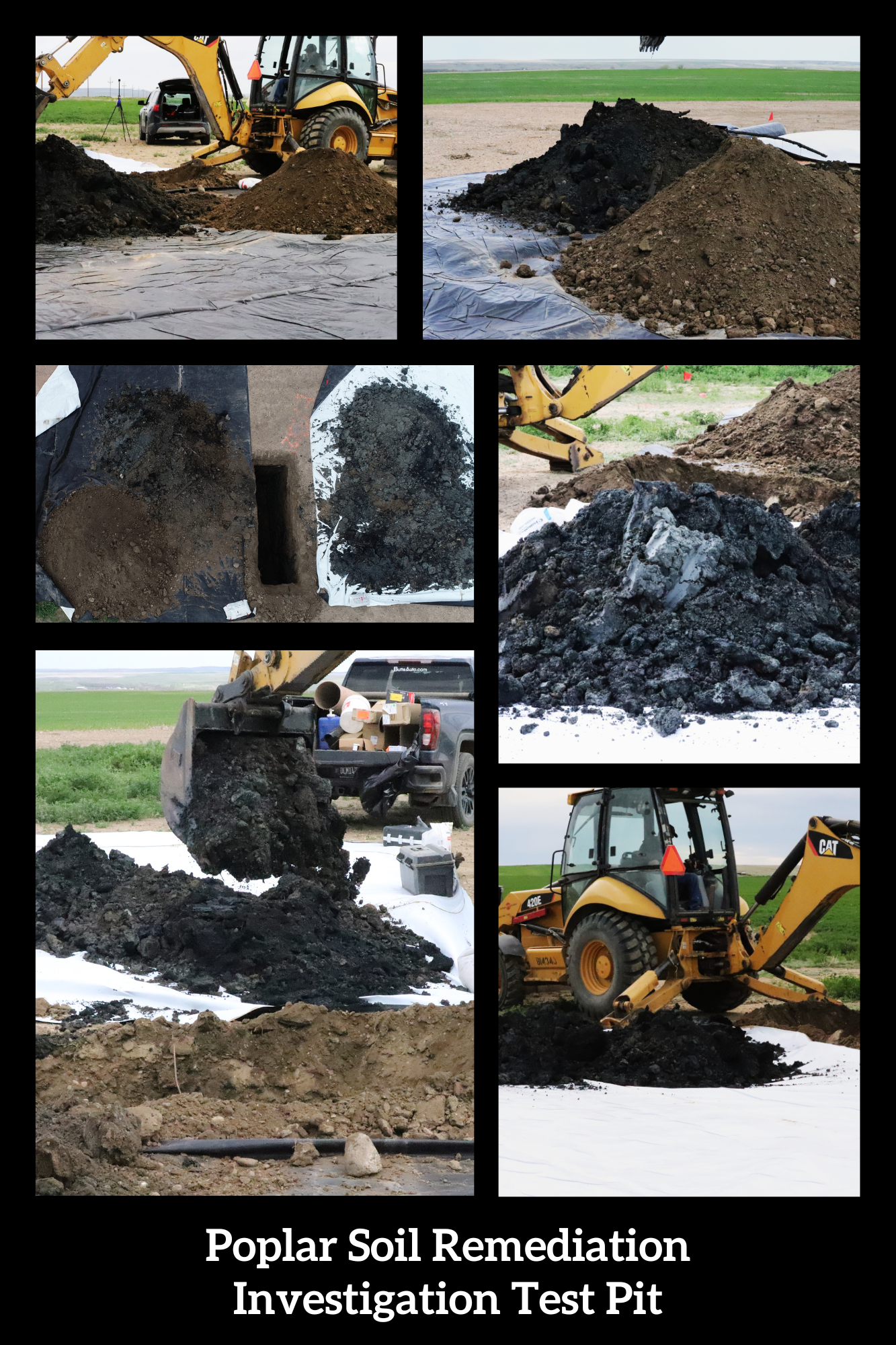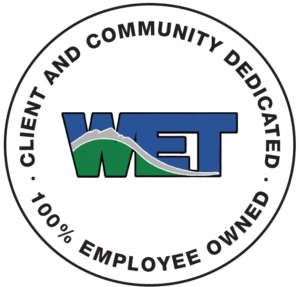POPLAR SOIL SHREDDING PROJECT
Poplar, Montana
Just northeast of Poplar, Montana, lies a region grappling with the legacy of oil exploration, which has left behind significant soil and groundwater contamination from several sources. One of the sources is a former waste pit used to dispose of crude oil, sludge, and emulsified hydrocarbons from nearby production and saltwater disposal wells. Over the years, this pit leaked crude oil deep into the ground, saturating the soil to depths over 30 feet below the surface and reaching the groundwater table.
Water & Environmental Technologies (WET) was brought in to tackle this environmental challenge using soil shredding technology. This innovative approach involves excavating the contaminated soil, breaking it into smaller pieces (or “shredding” it), and treating it with concentrated hydrogen peroxide to oxidize the hydrocarbons. Within 24 hours of treatment, soil samples are tested to ensure they meet the Montana Department of Environmental Quality’s (MTDEQ) Risk-Based Screening Levels (RBSLs) for petroleum hydrocarbons. Work began in July 2024 and was completed by October 2024. Surface restoration efforts will be completed in 2025. This effort demonstrates how targeted remediation can address environmental impacts from industrial activity while safeguarding the land for years to come.
Laying the Groundwork for Soil Remediation Near Poplar, Montana
In 2023, WET began planning the remediation of the contaminated soil at the former waste pit. The project’s primary objectives were to reduce hydrocarbon concentrations in the soil to levels below MTDEQ’s RBSLs and to safeguard the underlying aquifer from further contamination.
With over 30,000 cubic yards of contaminated soil to address, transporting it offsite for treatment wasn’t practical. Instead, onsite treatment was chosen as the most efficient and cost-effective solution. Following this decision, Unlimited Construction was brought on to execute the onsite remediation efforts. This approach highlights the importance of strategic planning and tailored solutions in tackling large-scale environmental challenges.
The project began with thoroughly analyzing existing data and then further defining the extent of contamination surrounding the former waste pit. This groundwork allowed the team to estimate the soil volume requiring treatment more accurately and create a targeted remediation strategy. Unlimited Construction brought its expertise in soil shredding technology, previously proven effective at other petroleum-contaminated sites, to work with WET to develop a work plan tailored to the unique conditions in Poplar.
Key elements of the project included treating the contaminated soil on site, collecting samples for testing at an analytical laboratory to ensure reliable data on petroleum hydrocarbons, and backfilling the treated soil. This underscored the importance of collaboration and site-specific solutions to enact effective soil remediation.
Progress in Soil Remediation
Unlimited Construction began mobilizing equipment to the site in June 2024, kicking off remediation efforts with a pilot test in July. Using a hydrogen peroxide application rate of four gallons per cubic yard of contaminated soil, the initial test successfully reduced volatile petroleum hydrocarbons (VPH) to non-detectable levels. However, extractable petroleum hydrocarbons (EPH) remained above the MTDEQ screening threshold of 200 mg/kg.
Additional pilot tests were conducted in August to refine the process. The peroxide application rates gradually increased to ten gallons per cubic yard to determine the most effective rate for reducing EPH concentrations. While overall EPH results stayed elevated, detailed fractionation confirmed that all individual compounds fell below RBSLs at the higher application rates of eight and ten gallons per cubic yard.
By October 2024, Unlimited had ramped up operations, treating approximately 3,000 cubic yards of contaminated soil daily. The project remained on track, and soil treatment and backfilling were completed by the end of that month. This showcased the effectiveness of methodical testing and scaling in large-scale remediation projects.
Captured by WET’s UAV during the first test pit digging near Poplar, Montana. The light brown soil pile shows the topsoil layer (0–2 feet deep), while the black soil pile reveals contamination from crude oil, sludge, and hydrocarbons found at (2–8 feet deep).
Prioritizing Safety and Compliance During Excavation
Safety played a central role in the project due to the challenging conditions on site. The excavation was set near an active tank battery with various utility lines—including product recovery and electrical lines, which required digging to depths exceeding 20 feet below ground surface (bgs). To minimize risks, the team conducted extensive pre-excavation planning to ensure buried utilities were identified ahead of time. GeoSearch Services provided utility locating and potholing services to identify buried utilities, preventing potential spills from damaged recovery lines or injuries from contact with live electrical lines.
Additionally, federal regulations required a professionally engineered excavation plan for digging beyond 20 feet bgs. A site-specific plan detailing the appropriate sloping based on soil type and excavation depth was developed to ensure stability and worker safety. A Stormwater Pollution Prevention Plan (SWPPP) was implemented to further comply with environmental regulations, addressing stormwater runoff and preventing contamination beyond the site boundaries. This rigorous focus on safety and compliance ensured the project met industry standards while protecting workers and the surrounding environment.
Inspiring the Next Generation of Engineers
Projects like the soil shredding cleanup near Poplar, Montana, demonstrate engineers’ vital role in designing a more sustainable future. By using innovative methods to remediate contaminated land and protect natural resources, engineers help restore ecosystems and create healthier communities. But this critical work relies on the ingenuity and dedication of future engineers.
As we celebrate Engineering Week 2025, we recognize the need to inspire the next generation of problem solvers. Their fresh perspectives, creativity, and commitment to sustainability will drive the next wave of environmental solutions. The challenges of tomorrow will require bold ideas and cutting-edge technologies, and future engineers will lead the way.
Conclusion
The Poplar Soil Shredding Project exemplifies how innovative methods, strategic planning, and adaptability can address complex environmental challenges effectively. The project successfully reduced hydrocarbon contamination to levels compliant with MTDEQ’s RBSLs by leveraging soil shredding technology and hydrogen peroxide treatment. Despite unforeseen challenges, such as laboratory delays and supply chain issues, the team’s proactive adjustments ensured the project stayed on schedule and within budget. Collaboration between WET, Unlimited Construction, GeoSearch Services, and other contractors proved instrumental in meeting safety and compliance standards while protecting the local environment. This project not only remediated contaminated soil but also laid the groundwork for future environmental restoration efforts, demonstrating the potential of targeted remediation to reclaim and safeguard valuable land.
This three-dimensional model was developed using subsurface soil data gathered from test pitting and exploratory drilling to define the extent of contamination resulting from the waste pit. The initial view shows the surface boundary with a red dotted line. Extractable petroleum hydrocarbon (EPH) contamination is shown in the subsurface using the red gradation, with darker red indicating higher concentrations and lighter red indicating lower concentrations. The gray lines from the surface extending underground indicate where exploration drilling was performed.







